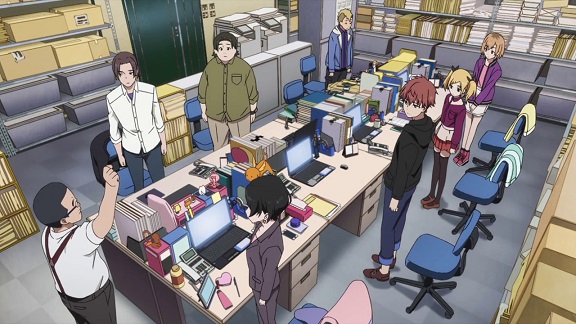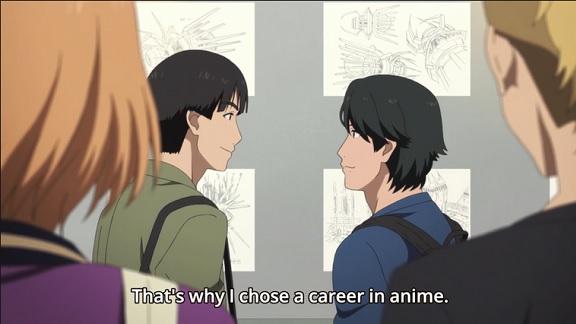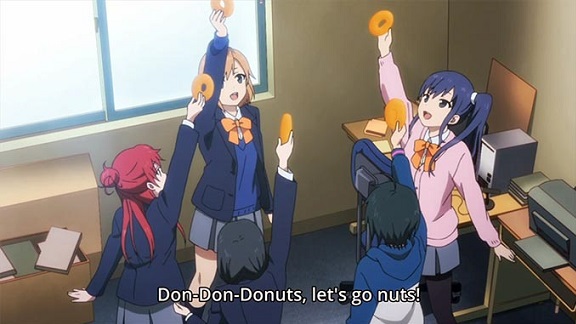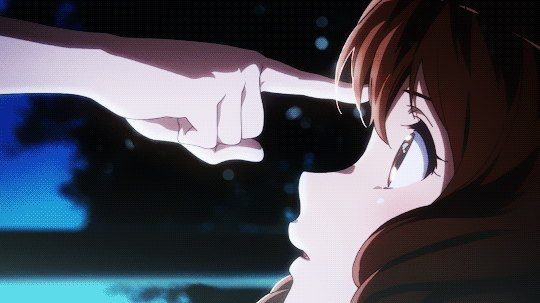
Remember when I said Shirobako was too good to watch quickly? I lied. instead, what i did was basically inhale the entire twentyfour episode series over the course of a weekend because it was just too good not to. This is one of the best, if not the best anime series I’ve seen in a long time, perhaps only matched by Ghost in the Shell: Standalone Complex which I binge watched earlier this year.

Three reasons why I liked this so much: 1) its love for anime as a profession and medium, 2) its great, female centered cast (without the usual sexist bullshit of a lot of female centered anime) and 3) it’s a properly adult story about doing a job you love in an industry you love, with all the ups and downs that entails, that manages to be upbeat without losing sight of the realities of working in an industry build on exploiting the dreams of the people working in it.

To start with the last, Shirobako follows the production of two successive anime series put out by Mushashino Animation, a smallish studio that has seen better years, mostly through the eyes of Aoi Miyamori, a production assistant, who vowed to break into the anime industry when in high school, together with her four friends of the anime club. Any notion of glamour though is largely forgotten under the pressure of getting Exodus, Mushashino’s first big new series in years, onto the television screen in time. Much of Miyamori’s work therefore consists of her running around between the various people involved in making anime, both in the studio and as freelancers: animators, 3D designers, colourists, sound production, etc, to get the work that needs done for the episodes she’s responsible for.

That felt really familiar from working on big software projects, especially the frantic search for solutions when deadlines come close and things go wrong. In the second part of the series this gets even worse, as Miyamori is promoted to production desk, now responsible for coordinating the entire series of the new anime, The Third Girls Aerial Squad, rather than just individual episodes. Interestingly, it’s this part of the series which has most of the “as you know, Bob” explanations you’d expect earlier, somewhat justified by Miyamori learning the ropes of her new role, while the first few episodes instead almost drown you with jargon and the introduction of the many, many, people you need to make an anime.

Which brings me to the second reason for why I like this series so much: its great cast. It’s centered around five high school friends who all are now either working in the anime industry or trying to break into it. Besides Miyamori, there’s Ema Yasuhara, working as a key animator at the same company, Misa Tōdō, working as a 3D computer graphics animator at a company specialising in doing cars, Shizuka Sakaki, an aspiring voice actress and Midori Imai, still in university and who wants to become a script writer. Miyamori is the series protagonist, with the other four regularly checked in on. They made a vow together back in high school, that one day they’d all work on their own movie and they’re hard at work realising their dream.

But that’s only a small part of the total cast, as Shirobako, especially in the first several episodes makes a point of hitting you over the head with how many people it takes to make one anime series. That picture above shows the staff of Mushashino Animation, which in itself is only a smallish studio. You’d think you’d drown in such a large cast, but the series is actually quite good at giving almost everybody their own personality. Though the focus is on the main five friends and especially Miyamori, the rest of the cast isn’t neglected either.

As you expect in any workplace, there are personal conflicts, people agonising about their career choices, slackers, high achievers, careerists and dropouts. What’s noticably absent are the office romances. That’s refreshing; so many supposedly work based stories treat work as just the background activity to focus on romance. Yet there is pleasure in seeing competent people work together to resolve real problems and Shirobako proves that this makes for just as gripping stories as a more conventional romance story would be. What’s also refreshing is that there are no out and out villains here: even a screwup like production assistant Tarō Takanashi, pictured above, who was responsible for some of the biggest crisises in the first half of the series, learns from his mistakes and gets better. (Note: apparantly some of this is inspired both by the director Tsutomu Mizushima’s own past mistakes as well as the experiences P.A. Works had making Girls und Panzer, which twice had to resort to recap episodes due to screwups.)
With Shirobako‘s focus on Miyamori and her work as production assistant and then production desk, most of the plot therefore revolves around the production process of the two series, but her friends go through their own crisises too. Ema Yasuhara has to grow as a key animator to be able to keep up with the work demanded of her, while Misa Tōdō is well appreciated by her company and good at what she does, but is conflicted in whether she’d be better off moving to a 3D graphics company that does more varied work. Midori Imai meanwhile sort of gets her wish of breaking into the industry by becoming a researcher at Mushashino Animation, while Shizuka Sakaki struggles for most of the series getting even bit parts voice acting. It all works out in the end though, as the five get their wish to work on an anime series together. Sort of.

And of course at the heart of the series is the love of anime . While people have doubts, fail, burn out and recover, underneath it that love remains. So when a key animator and a CGI creator — after meddling by Tarō Takanashi again– fall out over who gets to do a key scene, it’s no surprise its their shared love of a thinly disguised Space Runaway Ideon which reconciles them.
Another example is the series that got the main protagonist Aoi Miyamori interested in anime and a career in it: Andes Chucky, a shoutout to the real life Rocky Chuck. In one of the early episodes we see her hum the theme tune walking home after having gone out with her friends one night. In episode 19, we get the full ending credits as a replacement to the normal ending song. In between it turns out one of the key animators on the series is still working at Musashino Animation, who becomes somewhat of a mentor to Ema Yasuhara.

You could argue that Shirobako paints a rose tinted picture of the anime industry, even with all the problems and stress shown, especially in how the five high school friends in the end all seem to have made it in the industry. Yet on the other hand it’s not unknown for such a cluster of talent to make it through in real life, while especially Shizuka Sakaki barely has her feet on the ladder. It is self mythologising, but it’s well done and far from saccharine so I don’t care.

















